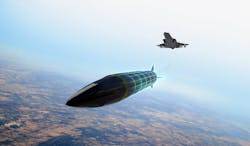Companies move forward with RF signal-homing air-to-ground missile to attack enemy missiles and radar sites
EGLIN AIR FORCE BASE, Fla. – Three U.S. defense systems integrators are moving forward on a project to build a next-generation air-launched RF signal-homing missile designed to attack missile and rocket launchers, artillery batteries surface warships, air bases, as well as radar and electronic warfare (EW) transmitters.
Officials of the Air Force Life Cycle Management Center at Eglin Air Force Base, Fla., announced $18 million six-month contracts in late February to Lockheed Martin Corp.; Northrop Grumman Corp.; and L3Harris Technologies Inc. for phase 1.3 of the Stand-in Attack Weapon (SiAW) program.
SiAW is to be an Air Force air-to-ground weapon designed to hold at risk surface elements of the anti-access/area denial (A2/AD) environment. Details of SiAW phase 1.3 are classified.
It's expected that the SiAW will have radio signal-homing guidance similar to the U.S. Army Lockheed Martin long-range Precision Strike Missile (PrSM), which seeks out enemy RF energy, but can remain difficult to detect by not emitting its own radar signal.
Initial SiAW contracts were awarded in 2020 to the Lockheed Martin Corp. Missiles and Fire Control segment in Orlando, Fla.; the Northrop Grumman Defense Systems segment in Northridge, Calif.; and the Mustang Technology subsidiary of L3Harris in Plano, Texas. The three companies won $15 million contracts in August 2022 for SiAW phase 1.2.
SiAW will capitalize on enabling technologies developed for the U.S. Navy Advanced Anti-Radiation Guided Missile-Extended Range (AARGM-ER) anti-radar missile program.
Modifications will make the weapon suitable for fifth-generation aircraft like the Lockheed Martin F-35 joint strike fighter and include a warhead, fuze, active radar homing guidance, and universal armament interface message to link the SiAW missile with Air Force F-35A versions of the joint strike fighter.
SiAW also will develop future advanced capabilities to keep it evolving for evolving threats. The program office is seeking capabilities from potential sources that are capable of these efforts.
The SiAW is expected to fit inside the F-35’s internal weapon bay, and eventually may go aboard the future Air Force B-21 strategic stealth bomber. SiAW could be ready for initial operating capability as early as 2026.
On these contracts Lockheed Martin will do the work in Orlando, Fla.; Northrop Grumman will do the work in Northridge, Calif.; and L3Harris will do the work in Plano, Texas. All three companies should be finished by 23 Aug. 2023.
For more information contact Lockheed Martin Missiles and Fire Control online at www.lockheedmartin.com; Northrop Grumman Mission Systems at www.northropgrumman.com, L3Harris Technologies at www.l3harris.com, or the Air Force Life Cycle Management Center at www.aflcmc.af.mil.

John Keller | Editor-in-Chief
John Keller is the Editor-in-Chief, Military & Aerospace Electronics Magazine--provides extensive coverage and analysis of enabling electronics and optoelectronic technologies in military, space and commercial aviation applications. John has been a member of the Military & Aerospace Electronics staff since 1989 and chief editor since 1995.

